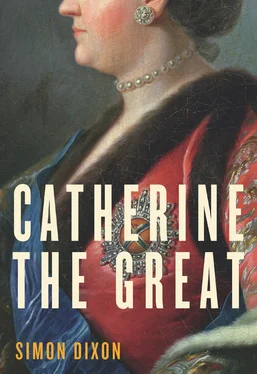In April 1790, the chief of the St Petersburg police entered Catherine’s inner sanctum to present her with Denis, a four-year-old boy of unknown origin found wandering the streets. Since no one had yet answered advertisements for his parents, the empress adopted him at the Court’s expense and placed him in the care of a courtier living close by the Hermitage. 98She was capable of demonstrative acts of kindness to those who had no right to expect them. Yet she was certainly no saint. Despite her idealised view of the Russian people as a whole, she took a dim view of many of the individuals she met on her travels, reserving some of her cattiest remarks for the earnest merchants’ wives who served her at table. Though her legislation allowed for a limited degree of social mobility, her policy was always to encourage her subjects to seek satisfaction in the station into which they had been born. As befitted a believer in a rigid social hierarchy, she relaxed only in the privacy of a narrow circle of aristocratic friends which remained remarkably constant throughout her fifty-two years in Russia (Ivan Betskoy, one of her first contacts at Elizabeth’s Court, died at the age of ninety-three in August 1795). Having begun her reign as a usurper, she sought a degree of legitimacy by portraying many of her early edicts as an attempt to complete the work of Peter the Great. But she was never a slavish imitator. 99On the contrary, having sought throughout to exceed the achievements of her glorious predecessor, she ended her life surrounded by images of her own triumphs on the European stage: paintings commemorating the battle of Chesme by the English artist Richard Paton were originally hung in the Hermitage but significantly moved in 1779 to the throne room at Peter’s own summer residence, Peterhof. 100Catherine had presided over the greatest expansion of Russian territory since the mid-sixteenth century and seen her empire’s economy grow in proportion. She had shown at least as great a commitment to the power of ideas as Peter I. But since she had ultimately been unable to trust the Enlightenment’s fundamental belief in self-development, a reign which began by fostering a degree of intellectual independence ended by enveloping some of Russia’s most interesting writers in clouds of suspicion. Catherine had not succeeded in her aim of establishing a firm rule of law, and the rational bureaucratic institutions she had worked so hard to establish never emasculated the informal patronage networks by which Russia has long been governed. Although she had offered her subjects the example of a tolerant and trusting ruler, her gentle methods have rarely been adopted by her successors. For them, the empress’s conduct has most often been an anti-model, not least because it has served as a subtle form of ammunition for their critics for most of the two centuries since her death.
AKV : Arkhiv kniaz’ia Vorontsova , ed. P. I. Bartenev, 40 vols. (M, 1870–95).
Beer and Fiedler: A. Beer and J. Ritter von Fiedler, eds, Joseph II. und Graf Ludwig Cobenzl: Ihr Briefwechsel , 2 vols. (Vienna, 1901).
Benois, Tsarskoe selo : Aleksandr Benua, Tsarskoe Selo v tsarstvovanie Imperatritsy Elisavety Petrovny (SPb, 1910).
Bentham: The Correspondence of Jeremy Bentham , vol. 2 (London, 1968), ed. T. L. S. Sprigge; vol. 3 (London, 1971), ed. I. R. Christie; vol. 4 (London, 1981), ed. A. T. Milne.
Bessarabova: N. V. Bessarabova, Puteshestviia Ekateriny II po Rossii (M, 2005).
Best: Voltaire, Correspondence and Related Documents , ed. Theodore Besterman, The Complete Works of Voltaire , vols. 85–135 (Banbury and Oxford, 1968–77).
Bezborodko: ‘Pis’ma A. A. Bezborodka k grafu Petru Aleksandrovichu Rumiantsevu’, Starina i novizna , 3 (1900), 160–370.
Bil’basov: V. A. Bil’basov, Istoriia Ekateriny Vtoroi , 2 vols. (Berlin, n.d.).
British Art Treasures : British Art Treasures from Russian Imperial Collections in the Hermitage , eds. B. Allen and L. Dukelskaya (New Haven, CT, 1996).
C.: Catherine II
CASS : Canadian American Slavic Studies
ChIOIDR : Chteniia v Imperatorskom Obshchestve istorii i drevnostei Rossiiskikh pri Moskovskom Universitete .
Corberon: Un diplomate français à la cour de Catherine II 1775–1780: Journal intime du chevalier de Corberon, chargé d’affaires de France en Russie , ed. L.-H. Labande, 2 vols. (Paris, 1901).
Correspondance : Correspondance de Catherine Alexéievna, Grande-Duchesse de Russie, et de Sir Charles H. Williams, Ambassadeur d’Angleterre , 1756 et 1757, ed. S. Goriaïnow (M, 1909).
Coxe: William Coxe, Travels into Poland, Russia, Sweden, and Denmark , 2 vols. (London, 1784).
Cross: Anthony Cross, By the Banks of the Neva: Chapters from the Lives and Careers of the British in Eighteenth-Century Russia (Cambridge, 1997).
Despatches : The Despatches and Correspondence of John, Second Earl of Buckinghamshire, Ambassador to the Court of Catherine II. Of Russia 1762–1765 , ed. A. d’A. Collyer, 2 vols. (London, 1900–01).
Dimsdale: An English Lady at the Court of Catherine the Great: The Journal of Baroness Elizabeth Dimsdale, 1781 , ed. A. G. Cross (Cambridge, 1989).
Engelhardt: L. N. Engel’gardt, Zapiski , ed. I. I. Fediukin (M, 1997).
Falconet: Correspondance de Falconet avec Catherine II 1767–1778 , ed. Louis Réau (Paris, 1921)
Grimm: ‘Pis’ma Imperatritsy Ekateriny II k Grimmu (1774–1796)’, ed. Ia. Grot, SIRIO , vol. 23 (SPb, 1878).
Harris Diaries: Diaries and Correspondence of James Harris, First Earl of Malmesbury , edited by his grandson, 4 vols. (London, 1844). Harris Papers: Music and Theatre in Handel’s World: The Family Papers of James Harris, 1732–1780 , eds. Donald Burrows and Rosemary Dunhill (Oxford, 2002).
KfZh : Kamer-fur’erskie zhurnaly, 1696–1816 (SPb, 1853–1917).
Khrapovitskii: Dnevnik A.V. Khrapovitskago 1782–1793 , ed. N. Barsukov (SPb, 1874).
Kutepov, Tsarskaia okhota : Nikolai Kutepov, Tsarskaia i imperatorskaia okhota na Rusi: Konets XVII-go i XVIII-i vek: Istoricheskii ocherk vol. 3 (SPb, 1900)
Lettere : Nikolai Ivanovic, la vostra lettera…: Lettere di Caterina II Romanov a N. I. Saltykov (1773–1793), Catalogo della Mostra 3 Novembre 2005 — 18 Febbraio 2006 (Milan, 2005).
Lopatin: Ekaterina II i G. A. Potemkin: lichnaia perepiska , ed. V. S. Lopatin (M, 1997).
M: Moscow
MP : Muzykal’yni Peterburg: Entsiklopedicheskii slovar’ XVIII vek , ed. A. L. Porfir’eva, 6 vols. in progress (SPb, 1996–).
McGrew: Roderick E. McGrew, Paul I of Russia 1754–1801 (Oxford, 1992).
Madariaga: Isabel de Madariaga, Russia in the Age of Catherine the Great (London, 1981).
Madariaga, Short History : Isabel de Madariaga, Catherine the Great: A short history (New Haven, CT, 1990). Montefiore: Simon Sebag-Montefiore, Prince of Princes: A Life of Potemkin (London, 2000).
Omel’chenko: O.A Omel’chenko, ‘Zakonnaia monarkhiia’ Ekateriny II: Prosveschennyi absoliutizm v Rossii (M, 1993).
Opisanie : Obstoiatel’noe opisanie torzhestvennykh poriadkov blagopoluchnago vshestviia v imperatorskuiu drevniuiu rezidentskkiu bogospasaemyi grad Moskvu i osviashchenneishago koronovaniia…Ekateriny Vtoryia, samoderzhitsy vserossiiskiia, materi i izbavitel’nitsy otechestva…1762 goda , published as appendix to KfZh , 1762 (SPb, 1855).
Читать дальше












